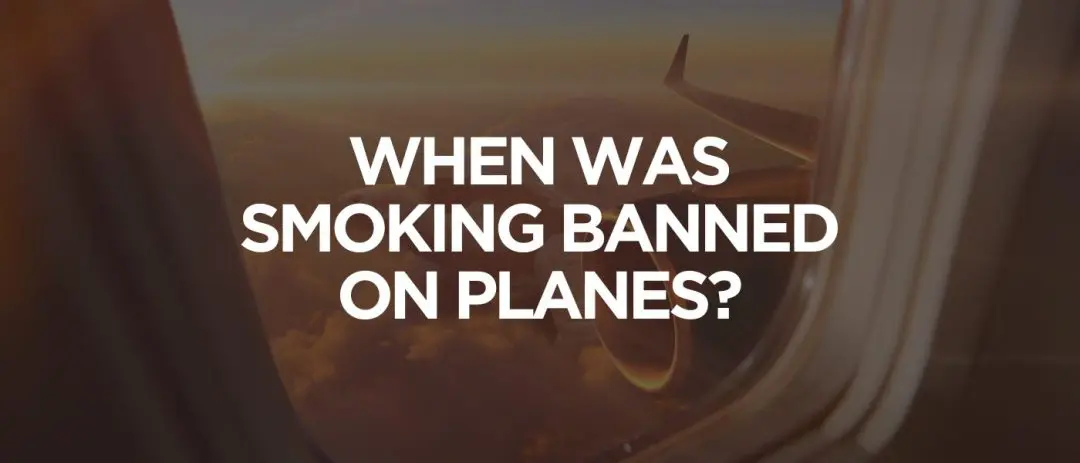Cigarettes, Laws
When Was Smoking Banned on Planes?
Before, smoking on airplanes around the world used to be a common sight. Passengers, for decades, could simply light up a cigarette in the middle of a flight. Some planes even have ashtrays built right into the armrests. Cabin crews would then serve drinks while surrounded by a smoky haze, while the smell of tobacco clung to the upholstery long after the flight had landed.
However, as awareness of the dangers of secondhand smoke grew, so did the pressure to ban smoking cigarettes in confined environments, including aircraft.
The transition to smoke-free skies in all domestic and international flights globally didn’t happen overnight. It took years or even decades of regulation changes, lobbying from flight attendants’ unions, public health advocacy, and shifting public opinion regarding smoking to reach the levels of bans we see today. Today, let’s take a look at the timeline of smoking bans on planes in key parts of the world, starting with Canada and then moving through Europe, the UK, Ireland, and India.
When Was Smoking Banned on Planes in Canada?
In Canada, the fight to ban smoking on airplanes began in the 1980s and continued through the early 1990s. Health advocates, passenger safety groups, and flight attendant unions played a significant role in pushing for smoking restrictions and ultimately, smoking bans.
The first significant step came in 1987, when the country banned smoking on domestic flights that lasted less than two hours. While this measure is a welcome benefit to non-smokers, it is still considered a compromise since it basically allows smokers to light up on longer flights. Despite the said compromise, this step has given short-haul passengers and crew some relief from the harmful effects of secondhand smoke exposure.
By 1990, the Canadian government expanded the ban to cover all domestic flights, regardless of their overall duration. This was seen as a major shift, reflecting growing concerns about the health risks of passive smoke. The ban was implemented under the Non-Smokers’ Health Act, which basically prohibits smoking cigarettes in federally regulated workplaces and public places.
Four years later, Canada took it one step further by entering a tripartite agreement with the United States and Australia, which basically bans smoking on all international flights operated by Canadian carriers and between the said countries. The federal government recognized the need for consistency, not only for the health of both smoking and non-smoking passengers and crew but also to align with international developments and airline practices in other parts of the world.
Transport Canada, the federal department responsible for transportation policies and programs, reinforced the policy in the following years. Today, no smoking is allowed on any commercial flight that departs from or arrives in Canada. This covers electronic cigarettes and vaping devices.
While cigarettes are banned inside the plane, you can still smoke them in designated smoking sections of a building or inside your home. You can get high-quality tobacco products here at NS4L.
When Was Smoking Banned on Planes in Europe?
The journey of Europe to smoke-free skies was similarly gradual and complex, with various countries and airline alliances implementing their own policies before continent-wide regulations were introduced and implemented thoroughly.
In the late 1980s, some European airlines started imposing smoking restrictions on domestic flights, especially those under two hours. For instance, Scandinavian Airlines (SAS) was among the first in Europe to implement smoking bans on its domestic flights operated by Linjeflyget in 1986. This followed smoke-free test flights, with most passengers, including the smokers, finding the experience to be more pleasant than flights that permit in-flight smoking.
In 1988, SAS extended the ban to all Norwegian and Swedish domestic flights. A year later, domestic services in these countries have also become subject to the inflight smoking ban of the airline. In the same year, flights between the Nordic nations started to embrace the no-smoking policy fully.
The real turning point came in 1997, when the European Union (EU) issued a directive that bans smoking on all flights within EU member states that last less than two hours. This directive, which is based on growing medical evidence of secondhand smoke risks and workplace safety, only sets the groundwork for a broader ban.
In 2000, the EU extended the ban to all intra-EU flights, regardless of their overall flight duration. This meant any flight taking off and landing within the EU territories must be smoke-free.
By 2006, virtually all European airlines had voluntarily banned smoking on international flights that last up to six hours or even more, aligning with the trend set by countries like Canada, the US, and Australia. At this point, the European skies had largely banned cigarette smoking.
In 2017, the European Aviation Safety Agency (EASA) reinforced the zero-tolerance stance by banning all forms of smoking completely, including e-cigarettes and vape devices, aboard all EU-regulated aircraft. This includes charter flights, low-cost carriers, and national airlines.
When Was Smoking Banned on Planes in UK?
The United Kingdom (UK) followed a trajectory that’s similar to that of the EU but had some of its own milestones, especially with iconic airlines like British Airways and Virgin Atlantic taking leadership in phasing out and banning smoking.
British Airways, which was the flagship carrier of the UK, began taking action in the mid-1990s. By 1990, it had maintained smoke-free environments on some flights shorter than two hours. Then, in 1998, the airline went further and implemented a complete ban on smoking on all its flights, regardless of route length. While it was a landmark decision that solidified the airline as a global leader in smoke-free travel, British Airways was actually among the last major airlines worldwide to implement a complete ban.
Virgin Atlantic followed shortly after. Other UK-based airlines, including low-cost carriers like easyJet and Ryanair, adopted strict no-smoking policies in the late 1990s and early 2000s.
Although not a formal legislative mandate at first, the UK’s Civil Aviation Authority (CAA) strongly encouraged all carriers to implement non-smoking policies due to safety and health reasons. Eventually, the UK’s stance aligned with broader European legislation, particularly after joining EU-wide smoking restrictions in aviation in the early 2000s.
Today, the UK has fully banned smoking, as no airlines allow cigarette smoking. This also covers the use of vape pens and e-cigarettes. Offenders of these policies may face hefty fines, removal from aircraft, and prosecution.
When Was Smoking Banned on Planes in Ireland?
Ireland has been progressive when it comes to public health and anti-smoking laws. In 2004, it was the first country in the world to impose a comprehensive workplace smoking ban. And under this regulation, commercial aircraft were considered workplaces.
Smoking bans on planes in Ireland, however, predate the 2004 legislation. Aer Lingus, the national airline of Ireland, had already moved toward smoke-free operations by the mid-1990s. The airline first introduced non-smoking sections on its aircraft and then gradually phased out smoking altogether.
By 1998, the same airline had prohibited smoking on all types of flights. This internal airline policy aligned with growing public sentiment against smoking cigarettes in enclosed spaces. With poor air circulation, smoking only enhances safety concerns such as the risk of onboard fires, oxygen system interference, and many other issues.
The general public smoking ban in Ireland in 2004 put aircraft, whether domestic or international, under the legislation as well. The said legislation covers all enclosed workplaces, including pubs, restaurants, and office spaces, ensuring second hand smoke won’t be a problem anymore. Any fire hazard may also be prevented through this policy.
Like other countries around the world, any flight operating to or from Ireland does not permit smoking or using vaping products. The Irish Aviation Authority enforces this policy strictly by giving out serious penalties and hefty fines to violators.
When Was Smoking Banned on Planes in India?
The aviation regulations in India regarding smoking underwent a significant transformation during the late 1990s and early 2000s.
You see, smoking was initially allowed on Indian flights, with separate sections for smokers and non-smokers. This setup, unfortunately, failed to adequately protect passengers and crew from exposure to cigarette smoke. Flight attendants frequently raised health concerns about inhaling smoke in-flight, while public health advocates began pushing for reform regarding smoking on planes.
In 2001, the Ministry of Civil Aviation issued a directive that banned smoking on all domestic flights. This is a clear reflection of increasing public health awareness in the country. The ban was comprehensive and applied across all airlines, including past national carriers like Indian Airlines and Jet Airways.
Two years later, the government extended the smoking ban to all international flights operated by carriers in India, which included Air India. This is covered by the Cigarettes and Other Tobacco Products Act, which bans smoking in public places, including aircraft.
The Directorate General of Civil Aviation (DGCA), India’s aviation regulatory authority, now enforces a strict total ban on smoking, including the use of electronic cigarettes or vape pens. Passengers who are caught violating the rule may face hefty fines, potential arrest, or being blacklisted from future flights.
India’s smoke-free policy on planes is now well-established. Most travellers from or to India, therefore, are aware that no smoking is tolerated on any flight, wherever they go.
Frequently Asked Questions
When did smoking on planes stop in Canada?
Smoking on planes in Canada began to stop and be phased out in 1987, with a full ban on all domestic flights enacted in 1990. The ban was extended to all international flights operated by Canadian carriers by 1994. Since then, smoking has been prohibited on any commercial aircraft in Canada.
When did airlines stop allowing smoking?
Airlines around the world stopped allowing smoking at varying times. Most of them started implementing partial bans in the late 1980s to early 1990s, often beginning with short-haul or domestic flights. By the mid to late 1990s, many major carriers had fully banned smoking. By the early 2000s, smoking on commercial flights was fully banned worldwide.
Which airlines still allow smoking?
As of now, no major commercial airline allows smoking on board. Even airlines in places with more relaxed smoking laws adhere to international aviation standards, which prohibit in-flight smoking.
Could you smoke on a plane in 1988?
In 1988, you could still smoke on a plane, especially on many domestic and international flights. During that year, some airlines had created non-smoking sections, but these were often ineffective. It then marked a transitional period as smoking bans in North America and Europe began to take shape. However, many long-haul and overseas flights still permitted smoking in designated areas at that time.
When did they stop smoking on international flights?
International smoking bans came later than domestic ones. In Canada, smoking on international flights was banned in 1994. In the US, the ban came in 2000. In Europe, most international bans were implemented between 1997 and 2000. Today, however, all international flights are smoke-free, including those operated by non-Western carriers.
Summary
The days of lighting up a cigarette mid-flight are long gone due to the strict no-smoking policies being implemented around the world. Aviation authorities, airlines, and health agencies have taken decisive action to eliminate smoking from commercial aircraft. This is the reason why you would spot smoke detectors in aircraft toilets and lavatories to ensure compliance. No smoking signs are also installed, reminding passengers and aircraft personnel of the said policies.
The shift toward smoke-free air travel reflects a broader global trend of prioritizing public health, occupational safety, and passenger comfort. It has also opened the door for future health-focused policies in aviation, which include restricting vaping products.
From Canada to India or across the EU, you can expect a clean, smoke-free cabin. It is a standard that is here to stay for a very long time, which helps to protect public health, ensure good air quality inside the plane, and keep the aircraft safe from any potential fire risk.
Do you want to know the history of cigarette ads that somehow became the cause of their popularity? If so, then read this article from Native Smokes 4 Less.


































































